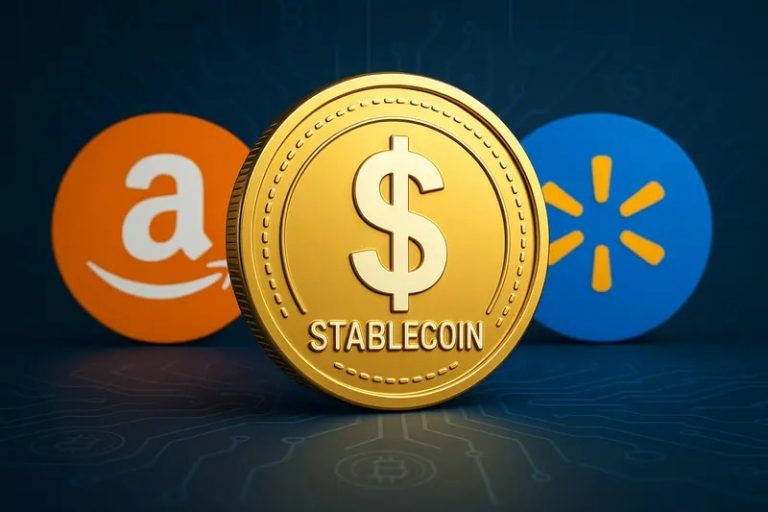
The Depository Trust & Clearing Corporation (DTCC), a cornerstone of U.S. financial infrastructure, is reportedly exploring the issuance of a U.S. dollar-backed stablecoin to enhance settlement and asset movement, pending regulatory clarity from Congress, particularly the GENIUS Act. This move aligns with DTCC’s prior work on tokenized collateral and distributed ledger technology, aiming for near-instant settlement and programmable money applications. The DTCC processes $2 quadrillion in securities transactions annually, and a stablecoin could streamline corporate cross-border treasury management and payment systems.
Similarly, retail giants Walmart and Amazon are considering issuing their own U.S. dollar-pegged stablecoins to reduce card processing fees, estimated at $14 billion annually, and speed up transaction settlements. Amazon reported $638 billion in revenue in 2024, with $447 billion from e-commerce, while Walmart’s e-commerce sales hit $100 billion in 2023. Stablecoins could bypass traditional banking systems, offering near-instant settlements compared to 1-3 days for card payments. Their plans hinge on the GENIUS Act, which recently passed a Senate procedural vote but awaits full approval. Some concerns exist, with critics like Senator Elizabeth Warren warning about unchecked corporate power in issuing stablecoins.
These developments reflect growing institutional interest in stablecoins, driven by potential cost savings and regulatory progress, though final outcomes depend on legislation and compliance paths. A DTCC-issued stablecoin could revolutionize securities settlement, reducing counterparty risk and capital lockup with near-instantaneous transactions. Its $2 quadrillion annual transaction volume underscores the potential to set a global standard for tokenized assets, enhancing liquidity and interoperability across financial systems.
Register for Tekedia Mini-MBA edition 19 (Feb 9 – May 2, 2026): big discounts for early bird.
Tekedia AI in Business Masterclass opens registrations.
Join Tekedia Capital Syndicate and co-invest in great global startups.
Register for Tekedia AI Lab: From Technical Design to Deployment (next edition begins Jan 24 2026).
Amazon and Walmart: Stablecoins could slash their $14 billion in annual card processing fees, enabling faster settlements (seconds vs. 1-3 days) and improving cash flow. This could lower consumer prices or boost margins, while integrating stablecoins into loyalty programs or supply chains could deepen customer and vendor lock-in. The GENIUS Act’s progress is pivotal. If passed, it could provide a clear framework for non-bank entities to issue stablecoins, fostering innovation but requiring robust compliance (e.g., 1:1 USD backing, audits). Without it, regulatory uncertainty may delay or deter launches.
Stablecoins from these giants could challenge existing players like Tether (USDT) and Circle (USDC), which dominate with $190 billion and $70 billion in market cap, respectively (as of June 2025). Their scale could accelerate mainstream adoption but risks market concentration. Faster, cheaper transactions could streamline global trade, remittances, and corporate treasury operations, particularly for cross-border payments, which currently cost $120 billion annually in fees.
Corporate stablecoins could enable unprecedented transaction tracking, raising surveillance fears. Unlike decentralized cryptocurrencies, these would likely be permissioned, giving issuers significant control over user data and funds. Lower-cost payment systems could benefit unbanked populations, especially in emerging markets, but only if accessible via existing platforms like Amazon Pay, Walmart apps.
The pursuit of stablecoins by DTCC, Amazon, and Walmart highlights stark divides in the financial and societal landscape. DTCC’s stablecoin would reinforce centralized financial infrastructure, leveraging its regulatory clout and systemic role. Amazon and Walmart’s versions would tie users to corporate ecosystems, prioritizing efficiency over decentralization. Crypto purists argue stablecoins should be community-driven or algorithmic (e.g., DAI), not corporate-controlled.
Centralized stablecoins risk censorship, account freezes, or manipulation, clashing with blockchain’s ethos of trustlessness. Amazon and Walmart issuing stablecoins could amplify their economic dominance, with combined 2024 revenues exceeding $1 trillion. Critics like Senator Warren warn of “private money” consolidating power, bypassing public accountability. Lawmakers and regulators (e.g., SEC, Fed) may impose stringent rules to prevent systemic risks, such as runs on stablecoins during market stress.
The GENIUS Act aims to balance innovation with oversight, but political divides could stall progress. Stablecoins could primarily serve corporate and institutional needs (e.g., treasury management, high-value settlements), with benefits trickling down slowly. While potential exists for financial inclusion, corporate stablecoins may prioritize profitable markets over marginalized communities. High smartphone or platform dependency could exclude rural or low-income users.
DTCC, Amazon, and Walmart’s stablecoins would likely launch in USD, reinforcing dollar hegemony. This benefits U.S.-centric economies but may limit adoption in regions with weaker dollar access. Developing nations could see reduced remittance costs, but reliance on U.S.-issued stablecoins risks economic dependency. Local stablecoin initiatives (e.g., Nigeria’s cNGN) may struggle to compete.
The implications of DTCC, Amazon, and Walmart issuing stablecoins are profound, promising efficiency and innovation but raising concerns about corporate control, privacy, and systemic risks. The divide—between centralized and decentralized finance, corporate power and regulatory checks, and global economic disparities—underscores the tension between transformative potential and the need for equitable, transparent systems.



